Authentic Filipino baskets can be found on online marketplaces, specialty stores, directly from artisans, and through importers.
Online marketplaces like Etsy and 1stDibs offer a wide selection of Filipino baskets, including both contemporary and antique pieces. For example, Etsy features various sellers offering handmade Filipino baskets, while 1stDibs showcases high-end and antique baskets.
Kultura Filipino is another platform that showcases baskets from local artisans.
Specialty stores and importers also offer curated selections of authentic Filipino baskets. These stores often work directly with local artisans to source their products, ensuring fair trade practices and high-quality items.
Buying directly from artisan communities guarantees fair trade practices but requires planning and research.
Each source offers unique characteristics and price points influenced by material, age, and artisan techniques. For example, baskets made from natural materials like rattan or bamboo tend to be more affordable than those made from rare or exotic materials. Antique baskets can also command higher prices due to their age and historical significance.
Online Marketplaces for Baskets
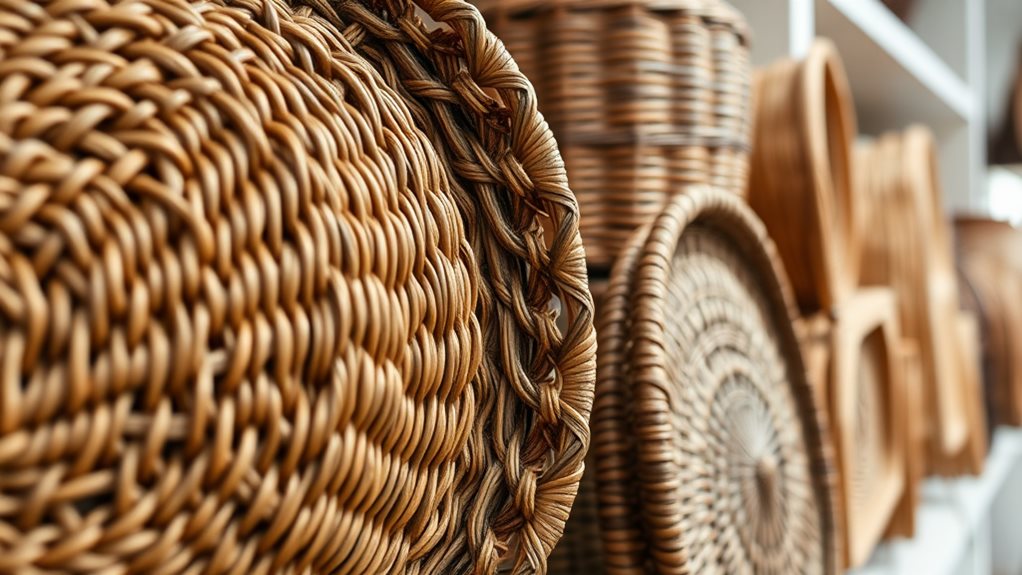
Authentic Filipino Baskets Can Be Found on Specialized Online Marketplaces.
To verify the authenticity of Filipino baskets, look for online platforms that prioritize sustainable sourcing and fair trade practices. Kultura Filipino is one such dedicated store specializing in Philippine crafts and supporting local artisans. These platforms showcase various styles, from functional storage baskets to decorative pieces, highlighting the cultural significance of each design.
When exploring online stores, check for detailed product descriptions that include information on the artisans' techniques and materials used. Customer reviews also provide valuable insights into product quality and seller reliability.
Specialized Philippine stores often partner with artisan communities to promote their unique basketry traditions. These platforms support preservation efforts and provide educational content about the craft. To ensure a responsible purchase, look for sellers who explicitly mention their commitment to sustainable sourcing and fair trade practices.
In contrast, general e-commerce sites require more scrutiny. Be cautious of unusually low prices and evaluate the seller's claims regarding origin and materials.
Verify certifications and partnerships with local artisan communities to protect against counterfeit products and promote responsible consumption****.
Exploring Etsy's Filipino Crafts
Etsy Offers Authentic Filipino Baskets****
Etsy is a platform where you can find authentic Filipino baskets made from natural materials like coco midrib and other organic fibers. These handmade pieces are unique and reflect traditional Filipino craftsmanship.
Etsy Shops and Sellers
You can find a variety of shops on Etsy, such as Kahulugan, ColorfulUnique, and NarraStudioNY, that specialize in Filipino crafts, including baskets. These shops offer a range of products, allowing you to explore different Filipino crafts beyond baskets.
Factors to Consider When Buying
When purchasing a Filipino basket on Etsy, consider the following factors:
- Materials are key to quality. Look for sustainable and natural materials used in the basket's construction.
- Craftsmanship reflects tradition. Pay attention to the attention to detail and traditional techniques used by the artisan.
- Design showcases cultural elements. Note the unique designs and whether they incorporate cultural elements, making the basket a true representation of Filipino craftsmanship.
Pricing and Customization
Prices for Filipino baskets on Etsy range from €20.88 to €162.36, depending on the size, intricacy, and seller. Some sellers offer discounts and sales, with up to 40% off.
You can also customize your basket to make it a truly unique item.
Supporting Filipino Artisans
1stDibs: Antique & Modern Pieces

Authentic Filipino Baskets on 1stDibs****
1stDibs features a curated selection of antique and modern Filipino baskets, showcasing the artistry and craftsmanship of Filipino basket weaving. These pieces represent various styles and materials, including natural fibers like rattan, reed, and abaca.
Antique and Modern Styles
The selection includes a range of 19th and early 20th-century handwoven baskets**, crafted from natural fibers like rattan, reed, and abaca. These baskets exhibit a rustic charm** due to their age and use.
In contrast, modern designs feature contemporary Lubid Abaca Baskets, available in diverse colors and sizes.
Basket Examples
- Karagumoy Grain Basket: A 19th-century piece from Yonkers, NY, with a weathered condition.
- Rattan Grain Basket: An early 20th-century piece from Yonkers, NY, also with a weathered condition.
- Reed Basket: A mid-20th-century piece from Miami, FL, in good condition.
- Lubid Abaca Basket: A 21st-century piece from New York, NY, in excellent condition.
- Leaf Basket: A piece of unknown origin from Miami, FL, in good condition.
Purchase Details
Each basket's origin and age are documented, along with detailed descriptions of its condition.
Experienced sellers on 1stDibs guarantee authenticity and exceptional quality. Global shipping is available, and a 3-day return policy provides peace of mind.
Kultura Filipino: Local Artisans
Supporting local artisans is essential to preserving cultural heritage and authenticity in Filipino baskets**. Commercially available baskets are convenient, but they often lack the unique characteristics and techniques that local artisans provide. Each region in the Philippines has its own distinct styles, such as the Pala'wan artisans who use bamboo, nito vine, and enapung for intricate plaiting, and the Ibaloi weavers in Banayakeo who excel in traditional bamboo crafting**.
Filipino baskets are crafted from natural fibers with diverse properties. Bamboo provides strength, rattan offers flexibility, and nito adds delicacy. Understanding these materials enhances appreciation for the artisan's skill. For example, the bakat, a bamboo lattice basket from Cebu, showcases regional specialization.
To support local artisans and preserve cultural heritage, consider the following:
- Purchasing baskets directly from artisans or cooperatives ensures fair compensation and preserves traditional techniques. This approach bypasses intermediaries and allows for a more direct connection with the artisans.
- Attending or supporting weaving festivals celebrates the artistry and cultural significance of Filipino basketry. These events provide opportunities to connect with artisans and learn about their craft.
- Participating in or supporting training programs transmits traditional knowledge to younger generations. This helps maintain the cultural heritage embodied in these exquisite creations and ensures the continuation of this valuable craft.
FEA Home: Antique Basket Selection
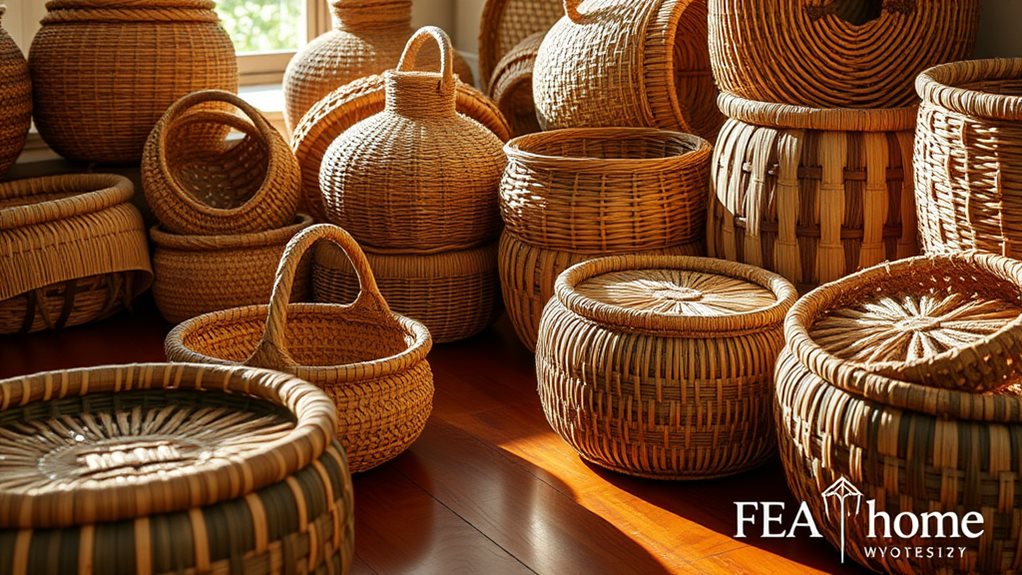
FEA Home offers a curated collection of antique Filipino baskets. These handwoven rattan baskets primarily date back to the 19th century and represent a segment of their larger inventory of antique Asian and vintage Chinese goods.
The baskets showcase Filipino basket history through their intricate designs and traditional weaving techniques. Each basket is a unique artifact, reflecting the craftsmanship and materials inherent to Filipino culture. Natural materials, primarily rattan and wood, are often aged, contributing to their rustic charm.
Traditional weaving techniques employed in these baskets demonstrate the skill of the artisans.
These baskets aren't just decorative; they're tangible links to the past. Their construction reveals a deep understanding of natural materials and their properties. Studying these baskets provides insight into the evolution of Filipino weaving styles. A range of styles and sizes are available, each telling a unique story of its creation.
Prices vary greatly, depending on rarity and historical importance. Some pieces are available for under $250, while others exceed $500. Detailed descriptions and high-resolution images are provided online, allowing for careful examination of each piece before purchasing.
Filtering by price is also possible to find items within your budget.
Specialty Stores: Ethnic & Traditional
Authentic Filipino baskets can be found in specialty stores that focus on ethnic and traditional crafts. These stores offer a diverse range of baskets that reflect the rich cultural significance of this craft. They often showcase the intricate basket making techniques employed for generations.
TESOROS is a store that specializes in high-quality embroidered crafts, including baskets from traditional materials. They offer baskets made from Piña-Silk, Jusi, and Cocoon, highlighting the cultural significance of these materials and the artistry involved.
Other stores like Para Sa'Yo offer curated collections of traditional crafts and baskets made by Filipinx artisans. They emphasize the connection between the artistry and the cultural heritage.
Online platforms like Etsy provide access to numerous independent sellers, such as Kahulugan, ColorfulUnique, and sarisaristoreatibaph, offering handmade baskets with detailed descriptions of materials and techniques used. This adds to the understanding of the cultural significance of the baskets.
Local Filipino markets and cultural centers are also a good source for traditional baskets. They often stock baskets made with natural fibers like rattan, bamboo, or abaca.
Look for hand-woven pieces that demonstrate skilled basket making techniques passed down through generations. Consider the functional designs and decorative elements, reflecting the items' use and symbolic meanings.
Choosing from such sources allows you to directly support the preservation efforts dedicated to safeguarding these traditions.
Finding Baskets on Marketplaces
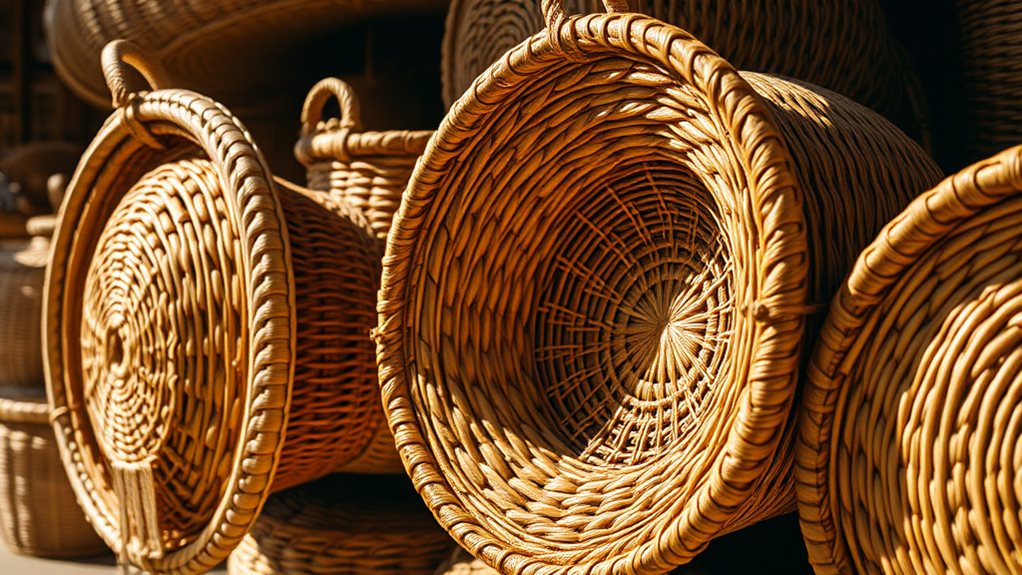
Locating Authentic Filipino Baskets
Finding authentic Filipino baskets requires exploring various marketplaces, both online and physical.
Online marketplaces provide a convenient way to find authentic Filipino baskets. 1stDibs and Etsy offer a curated selection of baskets, often showcasing the artistry of basket weaving and the cultural importance of these pieces. Additionally, Dapitan Arcade's online store directly supports Filipino artisans.
When shopping online, verifying authenticity is crucial. Carefully examine product descriptions and seller reputations to ensure the basket is genuine.
| Marketplace Type | Specific Example | Strengths |
|---|---|---|
| Online Marketplaces | 1stDibs, Etsy, Dapitan Arcade Online Store | Wide selection, convenience, global reach |
| Weekend & Specialty Markets | Salcedo Market, Dapitan Arcade | Direct interaction with artisans, opportunity to inspect quality |
| Artisan Platforms | Instagram, Facebook Marketplaces | Support local artisans, often unique, handcrafted items |
Physical marketplaces offer a different approach. Weekend markets like Salcedo and Sidcor in Manila provide opportunities to directly interact with vendors, evaluating the quality of materials and craftsmanship firsthand. Dapitan Arcade in Quezon City offers access to a wide variety of baskets, allowing comparison of different styles and techniques of basket weaving.
Exploring local bazaars and craft fairs throughout the Philippines also offers opportunities to discover unique pieces and support local artisans. Social media platforms like Instagram and Facebook can further enhance your search, where many artisans showcase their work.
The choice of marketplace greatly influences the experience and the level of authenticity you can verify.
Pala'wan Communities: Bamboo Crafts
The Pala'wan communities of the Philippines have a long history of producing intricate bamboo crafts, with the *tingkep* basket being one of the most notable examples. The *tingkep* is more than just a container, as it holds deep cultural significance and reflects Pala'wan traditions.
The creation of the *tingkep* involves several meticulous steps. The process begins with gathering materials such as bamboo, nito vine, and softwood, usually sourced within a short distance of the village. Skilled artisans then split the bamboo stalks into fine strips, requiring considerable expertise.
Preparation of these materials often takes longer than the weaving itself.
The *tingkep* has diverse uses, with its varied sizes reflecting its multiple functions. Historically, it has served as rice storage, a hunting tool, and even a spirit house. The basket's patterns, inspired by the forest's flora and fauna, are woven with blackened and natural bamboo strips.
These designs are passed down through generations, connecting the craft to the spiritual domain. The weaving process, employing single or double overlapping techniques, can take days or even weeks to complete.
Pala'wan traditions are closely linked to bamboo sustainability. Local ecosystems support the craft, contributing to forest conservation. Organizations like NTFP support sustainable forest management, training community members in wildlife protection.
The *tingkep* is a reflection of a harmonious relationship between humans and nature, symbolizing Pala'wan identity and generations-old skill.
Ibaloi Village: Traditional Baskets
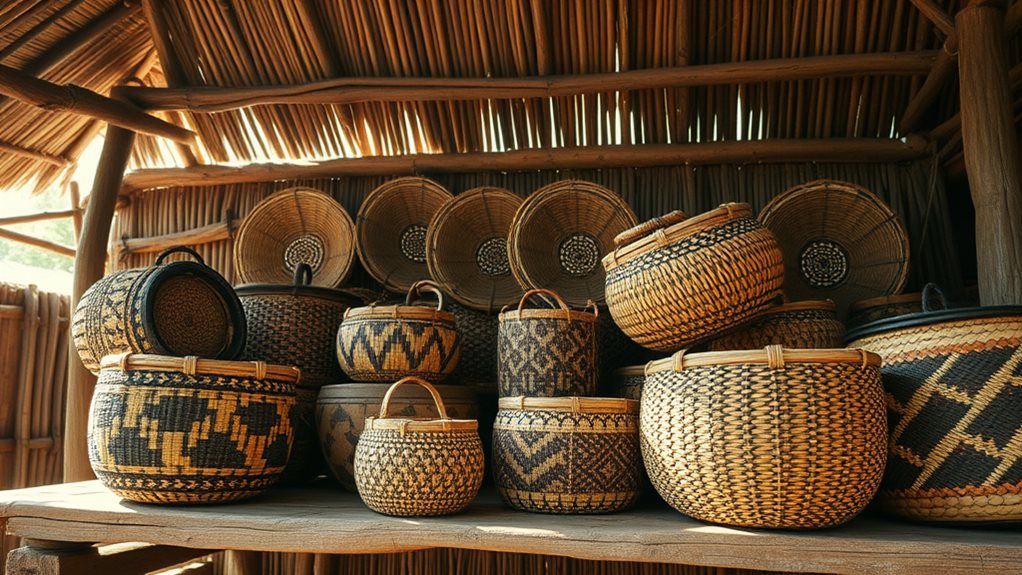
The Ibaloi people of the Philippines have a rich history of basketry, employing techniques and materials distinct from those of the Pala'wan. Bamboo is a primary material, meticulously prepared before weaving begins. Harvesting and processing the bamboo, including splitting stalks into fine, uniformly shaved strips using knives, takes considerably longer than the actual basket weaving itself.
Nito vine and other local materials supplement the bamboo, showcasing Ibaloi culture's resourceful use of readily available resources.
Basket weaving is a vital source of income for the Ibaloi people. Villagers create baskets, plant holders, and sun hats for market sales, contributing notably to their household economies. The Banayakeo Basket Weavers Association, supported by local government and NGOs, helps organize and promote sales. Proceeds from these sales directly contribute to fundamental purchases, including cooking oil, soap, and school clothing for children.
This basket weaving tradition is deeply ingrained in Ibaloi culture, serving diverse functions such as rice storage and hunting implements. Baskets sometimes even denote social status or group affiliation within the community.
Despite challenges like geographical isolation limiting market access, Ibaloi weavers demonstrate remarkable resilience and innovation. They've incorporated new techniques, such as Japanese plaiting methods, and experimented with innovative materials like recycled plastic cargo straps, maintaining the tradition while adapting to modern needs.
Training programs guarantee the continuation of this time-honored Ibaloi culture and basket weaving techniques for generations to come.
Visiting Indigenous Communities
Buying authentic Filipino baskets directly from indigenous communities supports local artisans and preserves cultural heritage****. This practice allows you to experience the rich cultural heritage of various regions in the Philippines. For instance, Palawan is known for its intricately woven *tingkeps*, while Northern Luzon is famous for its unique *pasiking* basket-backpacks. Mindanao also has its own distinct styles and materials.
Indigenous communities in the Philippines practice sustainable forestry**. Visiting these communities provides insight into their harvesting methods, which involve sustainably collecting materials like bamboo, rattan, nito vine, and enapung from ancestral forests. This approach reflects their deep connection with nature** and respect for the environment.
Buying baskets directly from indigenous communities contributes to cultural preservation**. By doing so, you learn about the cultural significance of the baskets, their use in rituals, and their role in the community's economy. This approach also ensures that artisans receive a fair price** for their work, bypassing intermediaries.
To ensure a successful visit, consider the following:
- Research is key: Research the accessibility and protocols for visiting specific communities to ensure a smooth experience.
- Engage respectfully: Engage respectfully with artisans and learn about their techniques and traditions to deepen your understanding.
- Support community initiatives: Support community initiatives that promote sustainable practices and cultural preservation to contribute to their well-being.
Community Centers & Local Markets
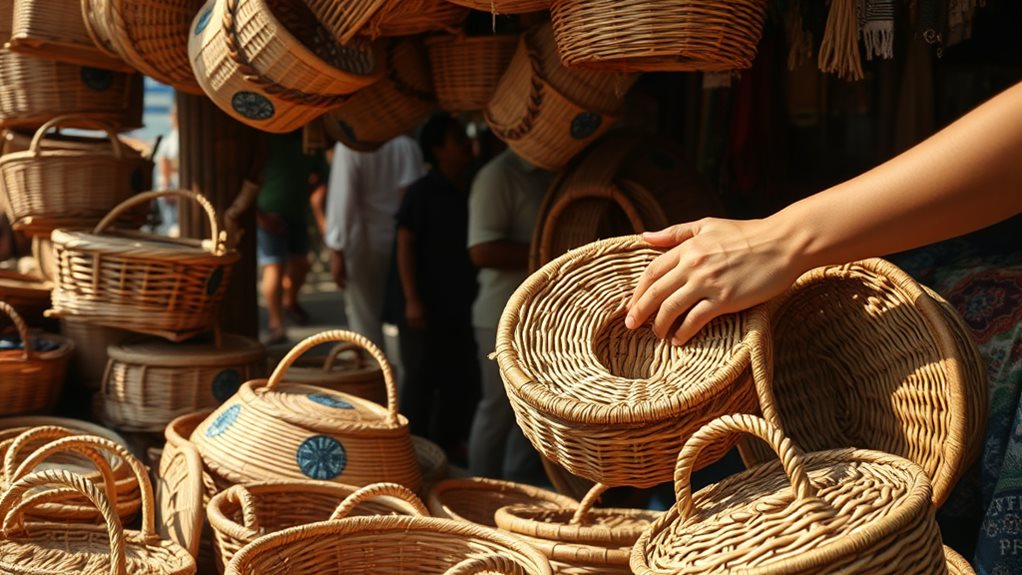
Community Centers Play a Key Role in Preserving Traditional Weaving Techniques****
Community centers frequently host artisans, enabling direct community engagement and collaboration.
These centers often offer training programs, improving the quality of baskets available. This market access helps preserve traditional weaving techniques and supports cultural heritage.
Some Community Centers Advocate for Sustainable Sourcing****
Some community centers actively advocate for ancestral land rights, ensuring the sustainable sourcing of raw materials.
This approach promotes environmental responsibility and contributes to the well-being of indigenous communities.
Local Markets Provide Direct Access to Authentic Filipino Baskets****
Local markets offer a diverse range of products, including mats, bags, and other handicrafts, made from materials like pandan, bamboo, and nito vine.
This direct sales approach increases weavers' earnings and contributes to the local economy.
Market Demand Influences Product Design Diversification****
Market demand, particularly for bags, has led to diversification in product design, moving beyond traditional mats.
This shift allows artisans to explore new ideas while still preserving traditional techniques.
Purchasing Decisions Support Artisan Collaboration and Community Engagement
By purchasing authentic Filipino baskets from community centers and local markets, you directly support both artisan collaboration and community engagement.
This fosters economic growth within these communities and promotes cultural preservation.
Museum Exhibits on Basketry
Museums worldwide house substantial collections of Philippine baskets, showcasing the country's diverse weaving traditions. The National Museum of the Philippines offers valuable insights into these artifacts, highlighting the cultural significance of Philippine basketry.
The museum details various weaving techniques employed across different regions and showcases the artistry and skill involved in their creation. You can examine baskets used for practical purposes, such as carrying or storage, and those with ceremonial or decorative functions.
The Fowler Museum at UCLA features a compelling display of 20th-century Philippine basketry****. This exhibit primarily showcases baskets from the Luzon Cordillera, highlighting the diverse forms and sizes, and intricate weaving techniques used by different ethnic groups.
Each piece is accompanied by detailed information exploring the interplay between form and function.
Museums like the University of Michigan provide historical context to Philippine basketry. Specimens collected during the American colonial period offer glimpses into the past and the historical evolution of the craft.
These artifacts are meticulously documented, with old tags pinpointing baskets' origins and intended uses.
Philippine basketry collections worldwide highlight the inherent cultural significance of this craft. Specific materials, such as bamboo, rattan, or nito vine, reflect regional variations in both weaving techniques and resource availability.
For example, Luzon's intricate designs and Mindanao's unique styles showcase the unparalleled artistry of Filipino weavers. These exhibits showcase not merely artifacts, but living cultural traditions.
NGOs Supporting Filipino Artisans
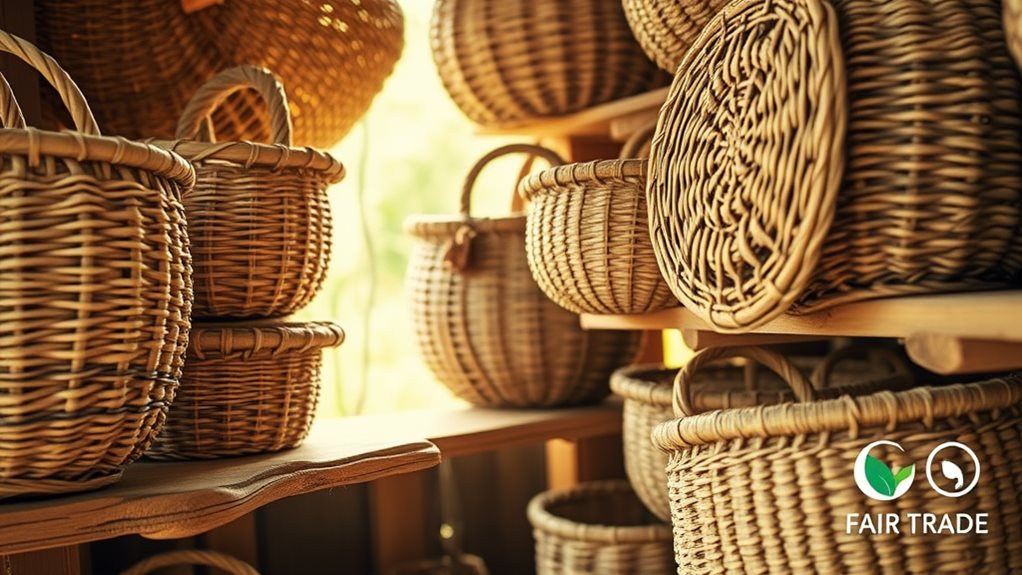
NGOs play a vital role in supporting Filipino artisans**. Numerous organizations facilitate the creation and distribution of authentic Philippine baskets through fair trade practices**.
The Community Crafts Association of the Philippines (CCAP) is a notable example. Founded in 1973, CCAP empowers community-based enterprises through fair trade practices. They focus on locally sourced materials like bamboo and rattan, providing development marketing strategies that support artisan communities.
Other organizations, like SERRV International, offer long-term partnerships and design assistance to Filipino artisans. SERRV International has partnered with Filipino artisans since the late 1970s and expanded their impact to include microfinancing and technical training****. This has benefited 28 producer groups, showcasing their commitment to artisan support.
Wovencrafts is another organization making a significant impact. Established in 2016, Wovencrafts modernizes traditional crafts by collaborating with women-led associations**. They provide capacity-building seminars** and technical skills training, more than doubling weavers' incomes in the Banig industry.
The NVC Foundation also plays a crucial role in supporting Filipino artisans. The NVC Foundation trains artisans to create high-value products and oversees design, production, and marketing. Their fair trade model directly benefits artisans and contributes to NVC's community programs.
These NGOs demonstrate diverse approaches to artisan support, highlighting their commitment to preserving Filipino craftsmanship and promoting fair trade principles.
Their unique perspectives and contributions have contributed to the sustainable growth of the Filipino basketry industry.
Specialty Stores & Importers
Purchasing Authentic Filipino Baskets Beyond NGOs****
Beyond NGOs, several options are available for buying authentic Filipino baskets. These options include specialty stores, online retailers, importers, and gift basket services that offer diverse selections and levels of customization.
Established Retailers
Kultura Filipino is a reliable option for purchasing authentic Filipino baskets. They offer a wide range of products that highlight the artistry of Filipino basket weaving.
Kultura Filipino provides personal shopping assistance and customizable corporate gifts****, ensuring that customers can find the perfect piece. Additionally, they're committed to quality and offer speedy international delivery.
Online Retailers
Online retailers like Para Sa 'Yo offer curated selections of Filipino baskets.
They feature gift boxes packed with items from Filipinx artists**, supporting local talent and offering unique, thoughtfully curated baskets. These retailers also support women-owned businesses** and offer easy-to-buy and send options.
Importers and Global Marketplaces****
Importers and global marketplaces like 1stDibs provide access to a broader selection of Filipino baskets, including antique and contemporary pieces.
They offer a global reach, shipping vintage and mid-20th-century decorative baskets. These marketplaces also offer a variety of materials, including bamboo, rattan, and other natural fibers, reflecting the rich history of Filipino basket weaving.
Choosing the Right Basket
When purchasing a Filipino basket, consider the specific type of basket you seek, whether it's a functional piece for everyday use or a decorative item.
Examine the materials used in construction and the craftsmanship exhibited, as authentic pieces often showcase intricate details and the skill of artisans.
Research the seller's reputation and commitment to fair trade practices**** to support ethical sourcing and sustainable practices within the Filipino basket weaving community.
Buying Directly From Artisans
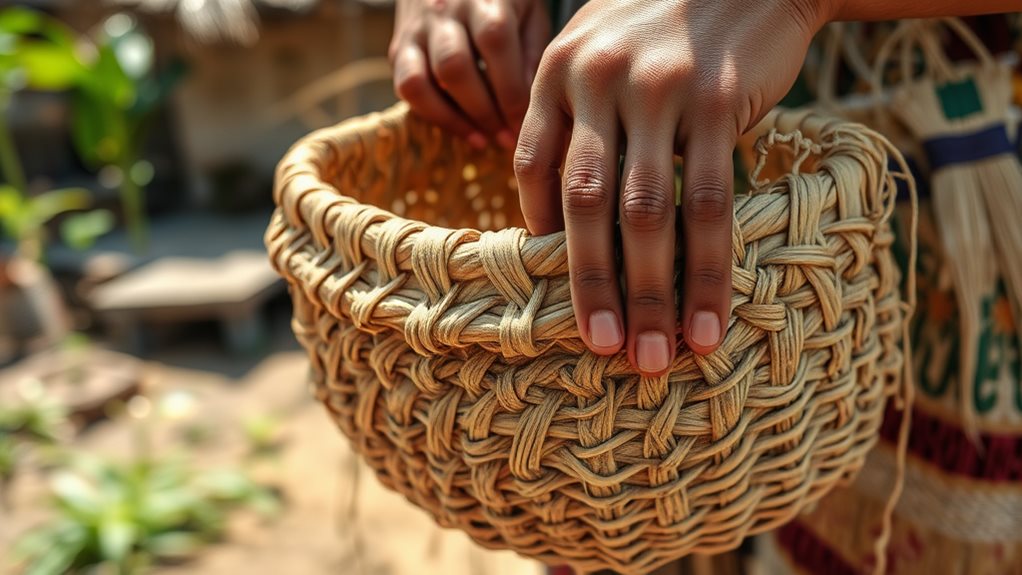
Buying Authentic Filipino Baskets Directly Supports Artisans
Purchasing authentic Filipino baskets directly from artisans is a powerful way to support the craft and its cultural significance. This direct engagement guarantees fair compensation for the artisans, promoting economic stability and the continuation of this age-old craft.
Indigenous communities like the Pala'wan in Palawan are known for their intricate weaving traditions. Organizations like the Banayakeo Basket Weavers Association facilitate sales, providing training and enhancing market access. This direct engagement also helps maintain biodiversity by promoting the sustainable harvesting of materials like bamboo, rattan, and nito vine.
Preserving Traditional Techniques and Cultural Significance
By buying directly from artisans, you support the preservation of traditional techniques and the cultural significance of these baskets. These baskets aren't merely functional; they are integral to ceremonies and rituals. For example, the Pala'wan community in Palawan uses these baskets in local ceremonies, reflecting their deep cultural ties.
Benefits of Buying Directly from Artisans
Buying directly from artisans has several benefits, including:
- Fair compensation for artisans: Ensuring that artisans receive fair pay for their work, promoting economic stability.
- Preservation of traditional techniques: Supporting the continuation of traditional weaving techniques and the sustainable harvesting of materials.
- Cultural significance: Preserving the cultural significance of these baskets and their importance in ceremonies and rituals.
Examples of Communities and Organizations
Several communities and organizations are working to preserve traditional Filipino basket-weaving techniques and support artisans. Examples include:
| Community/Group | Location | Support System | Economic Impact | Cultural Significance |
|---|---|---|---|---|
| Pala'wan | Palawan, Philippines | Local government, NGOs | Enhanced artisan livelihoods | Integral to local ceremonies |
| Kamantian | Mount Mantalingahan | Local government, NGOs | Increased economic stability | Reflects traditional practices |
| Banayakeo Weavers Assoc. | Various locations in Philippines | Local government, NGOs | Fair income for artisans | Preserves weaving techniques |
| Indigenous Communities | Multiple locations in Philippines | Local government, NGOs | Economic resilience | Deep cultural ties |
| Local Cooperatives | Multiple locations in Philippines | Various support structures | Improved marketing & sales | Maintains traditional knowledge |
Questions and Answers
How Can I Ensure Ethical Sourcing?
Seeking certifications is key to ensuring ethical sourcing. This can be achieved by looking for certifications such as Fair Trade Certified or B Corp, which verify that brands provide fair wages and decent working conditions. To further guarantee ethical sourcing, prioritize brands that showcase transparent practices. These brands should have clear and accessible information about their supply chains and sourcing processes. Additionally, supporting artisans and small-scale producers can also contribute to ethical sourcing. This can be done by choosing brands that actively work with and support these individuals, providing them with fair compensation and opportunities for growth.
What Are Common Filipino Basket Materials?
Filipino baskets are primarily made from natural materials. Traditional Filipino basket weaving often incorporates the following materials: bamboo, rattan, buri palm, pandan, tikog, and coconut. These materials are preferred for their durability and versatility.
What's the Average Price Range?
The average price range for baskets is $20 to $500+. This wide range in prices is due to factors like basket quality and age. For instance, antique baskets can be very expensive, often costing hundreds of dollars. On the other hand, contemporary baskets can be more affordable, with prices starting at $20.
How Do I Care for My Basket?
Dust your basket regularly to prevent dust buildup. This can be achieved by gently wiping the basket's surface with a soft cloth. For more thorough cleaning, use a damp cloth sparingly to avoid moisture damage.
When cleaning your basket, avoid harsh chemicals as they can damage the material or cause discoloration. Instead, opt for mild soap solutions or natural cleaning products specifically designed for your basket's material.
To maintain your basket's condition and prolong its lifespan, store it in a cool, dry place away from direct sunlight. This will prevent fading, warping, or cracking of the material.
Where Can I Find Basket-Making Classes?
Local artisans, community centers, and NGOs offer basket weaving classes. These classes can be found through various organizations that focus on traditional skills training programs. For example, the Textile Arts Council of San Francisco is one organization that provides such classes. Additionally, searching online or in local directories can help you find basket weaving classes in your area.